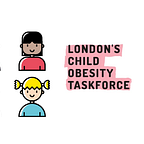How does the way children live effect their health and weight?
By Prof Corinna Hawkes, originally published July 2019
When I was first appointed to the London Child Obesity Taskforce, my first thought was: how can we make a difference? It turned out this was pretty much the first thought of all the Taskforce members .
Much has been done in London to get kids to a healthier weight: from the ad ban on London’s transport network to the Healthy Early Years programme; from the Daily Mile to the Healthier Catering Commitment; from Sugar Smart to Healthy Stadia.
Government , NGOs and businesses have not been idle. There have been some small gains: the percentage of kids aged 4/5 affected by overweight or obesity has declined from 23% to 22% since 2006/07. Some boroughs and wards can celebrate larger downward trends. But this is not the case everywhere — and for 10/11 year olds, the numbers swing ever upward, as does the difference between rich and poor. At age 10–11, a child in London’s poorest neighbourhoods is twice as likely to be affected by overweight or obesity then those living in London’s least deprived neighbourhoods.
The Mayor has shown his commitment to bringing about a change in children’s health and gave the Taskforce the job of seeing what else needs to be done. The Taskforce has discussed this. A lot.
We brainstormed and we made lists. We spoke to scores of people. We talked of the potential of a ‘whole-system approach’ and a ‘placed-based approach’. We talked about the role of lack of opportunity to be healthy vs lack of capability vs lack of motivation. We debated the role of the environments around people and of social determinants. We spoke about the transformation we wanted to unleash.
Returning from a Taskforce meeting one night on the tube, my eye caught a public service message I had seen many times before. The one where the kid says that their mum or dad didn’t want to talk to them that night because they felt stressed after being verbally abused at work. It’s a strong message. And it’s strong because it’s the voice of the child. This struck me particularly because that’s exactly what we had realised in the Taskforce: that the thing that needed to be done more than anything else was to hear from the very children for whom we wanted to make a difference.
So we went out and spoke with children and care givers to get a better grasp of how they spend their days, pulling what we learned together into four example profiles. What we found was revealing, albeit not entirely surprising.
Consider five year old Hannah. With her parents working long hours, she spends a lot of time with Grandma, who suffers from ill-health. Sugary cereal (from a box embellished with Hannah’s favourite characters), food from the freezer (bought on discount), online videos (full of advertising), and driving to school are the easiest and cheapest options for Grandma when she is caring for Hannah — and for her mum, given all the chores she has to catch up on when she is home.
Ten-year old Anik’s mum dedicates herself to keeping him and his sisters healthy — but worries about the safety of the park, the costs of sports activities and the fizzy drinks and fast food all around she knows are so tempting for her son.
Justin, two and a half, lives in a tiny flat, with no kitchen, no space to play, and no money for play activities. His mum feels isolated, down about being out of work, anxious about taking him to the park, challenged by the long bus-ride to nursery. So Justin doesn’t move much. Cheap snacks are a way of soothing his restless energy.
Jodie, at 16, looks after her nephew when her mum is cleaning offices in the evening, spending her times after school hanging out with her friends in the local chicken shops. She likes going there as the people serving the food let her and her friends stay for as long as they want and she doesn’t feel judged.
I can’t pretend to know what it’s like growing up in one of London’s poorer neighbourhoods. I didn’t — unlike some of the other members of the Taskforce. But by getting down to the kid’s level, I can begin to see the nature of the problem — and the potential solutions — much better.
I can see that it’s the way the negative influences combine in children’s lives that make it so difficult to shift the problem. I can see that we need a connected set of actions around children as they go about their daily lives, actions that help children of all ages to enjoy eating healthy diets, drinking water and moving more. I can see that we also need to address the nature of work, housing, and poverty for their parents and other care givers. I can see that we need children’s help in designing the actions we know are important. It’s no use asking food outlets to provide free water refills, for example, if children don’t feel welcome in these places, or if new water fountains are put in places seen as unsafe. If we are going to fix the system, we need to understand how people experience it on the inside.
When we start to think from the child’s perspective, things become clearer. A child-centred approach is not about targeting individual kids - it’s about understanding how the system around them can be changed in a way that meets them where they are. In changing the system, we can make a difference, helping kids grow up healthier, now, and for future generations.
